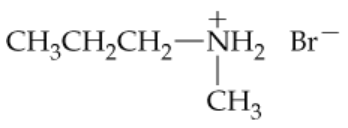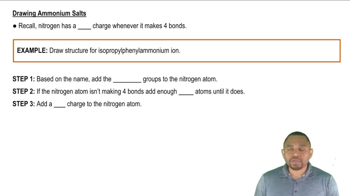Here are the essential concepts you must grasp in order to answer the question correctly.
Ammonium Salts
Ammonium salts are ionic compounds formed when ammonia (NH3) reacts with an acid, resulting in a positively charged ammonium ion (NH4+). These salts can be derived from primary, secondary, or tertiary amines, depending on the number of carbon-containing groups attached to the nitrogen atom. Understanding the structure of these salts is crucial for identifying their properties and reactivity.
Recommended video:
Drawing Ammonium Salts Concept 2
Primary, Secondary, and Tertiary Amines
Amines are classified based on the number of carbon groups attached to the nitrogen atom. Primary amines have one carbon group, secondary amines have two, and tertiary amines have three. This classification affects the amine's reactivity and the type of ammonium salt formed when they react with acids, which is essential for determining the structure of the resulting ammonium salt.
Recommended video:
IUPAC Naming: Primary Amines Concept 2
Nomenclature of Ammonium Salts
The nomenclature of ammonium salts involves naming the ammonium ion and the anion derived from the acid. The name typically includes 'ammonium' followed by the name of the anion. Familiarity with IUPAC naming conventions is important for accurately identifying and naming these compounds, especially when distinguishing between salts derived from different types of amines.
Recommended video:
Drawing Ammonium Salts Concept 2

 Verified step by step guidance
Verified step by step guidance Verified video answer for a similar problem:
Verified video answer for a similar problem:



 :55m
:55m